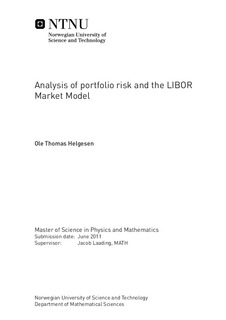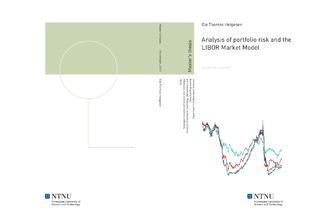| dc.description.abstract | This master thesis focuses on interest rate modeling and portfolio risk analysis. The LIBOR Market Model is the interest rate model chosen to simulate the forward rates in the Norwegian and American market, two very different markets in terms of size and liquidity. On the other hand, the Norwegian market is highly dependent on the American market and the correlation can be seen clearly when the data sets are compared in the preliminary analysis. The data sets are from the time between 2000 and the early 2011. Risk estimates are found by Monte Carlo simulations, in particular Value at Risk and Expected shortfall, the two most commonly used risk measures. Interest rate modeling and risk analysis requires parameter estimates from historical data which means that the Financial Crisis will have a strong effect. Two different approaches are studied: Exponentially Weighted Moving Averages and (equally weighted) Floating Averages. The main idea is to cancel out trend and capture the true volatility and correlation. Risk is estimated in several different markets, first an imaginary stable market is assumed. In the next steps the Norwegian and the American market are analyzed. The volatility and correlation varies. Finally we look at a swap depending on both Norwegian and American interest rates. In order to check the risk estimates, the actual losses of the test portfolios are compared to the Value at Risk and the Expected Shortfall. The majority of the losses larger than the risk estimates occur between 2007 and 2009 which confirms, not surprisingly, that the risk measures were unable to predict the Financial Crisis. The portfolios have a short time horizon, 1 day or 5 days, and the EWMA procedure weighs the recent observations heavier, thus it performs better than the Floating Averages procedure. However, both procedures consistently underestimate the risk. Still the risk estimates can be used as triggers in investment strategies. In the final part of this thesis such investment strategies are tested. Plotting the cumulative losses and testing the strategies shows that the risk estimates can be used with success in investment strategies. However the strategies are very sensitive to the choice of the risk threshold. Nonetheless, even though the model underestimates risk, the backtesting and the plots also tell us that the estimates are fairly proportional to the real losses. The risk estimates are therefore useful indicators of the development of the exposure of any financial position, which justifies why they are the most commonly used risk measures in financial markets today. | nb_NO |

